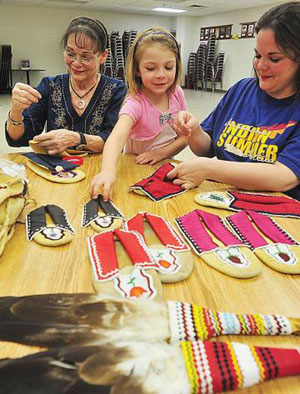Chief Ensures Moccasin Art Continues
 By Abigail Singrey
By Abigail Singrey
asingrey@examiner-enterprise.com
Saturday, March 26, 2011 10:07 PM CDT
The art of moccasin making has been passed down through the generations in Delaware Chief Paula Pechonick’s family, and now she sees it as her mission to make sure the tradition continues.
Pechonick’s great-great-grandmother was a moccasin-maker, and she used to travel to Pawhuska — which was an oil boom town at the time — with a load of moccasins to sell. More recently, Pechonick’s aunt — Anna Anderson Davis — passed down the art to other members of the family.
Now, Pechonick has accepted the baton from the women who went before her. Through her classes, which happen about once a year, Pechonick has saved the art of moccasin making within the Delaware tribe, Annette Ketchum said.
Tribal council member Jan Brown says Pechonick taught her in 1993, and “I just fell in love with it,” she said. She has taught her own family members now, she said, and one granddaughter embroidered a University of Oklahoma emblem on hers.
“I love it when they take it and run further than you teach them,” Brown said.
Moccasin makers “really were few and far between” before the classes, Pechonick said. “A lot of … Delaware women make their moccasins now.”
The moccasins are a key element of the traditional clothing, which for women also includes a taffeta shirt, wool skirt, tulip purse, shawl and fan.
It takes around 30 hours to make a moccasin, Pechonick said. After the buckskin is stretched and a pattern is used to cut it, then it is gathered in the toe and the tongue is stitched on. Pechonick also frequently uses elk hide rather than deer hide to make the moccasins sturdier, she said.
“The trick to making moccasins is that you sew them on both the inside and on the outside, and that makes them sturdy,” Pechonick said.
The beadwork is the most laborious part of the process, she said.
Unless she is copying a pattern from someone else, Pechonick always starts her round pattern on the toe of the moccasin with two rows of white beads and then a row of a dark contrasting color, she said.
Pechonick has come a long way in learning the craft since her first few pairs of moccasins, she said. She had looked at some moccasins at a powwow, and decided that she could make them.
When her aunt saw the final results, she decided to give Pechonick some tips on the craft.
“Aunt Anna kind of talked in parables to us, so she told me a story about moccasins without insulting my moccasins,” Pechonick said.
Now Pechonick enjoys seeing others make their own first pairs, even if the results don’t turn out quite as they had hoped.
“One gentleman came in to class and said, ‘Look, I beaded a flying squirrel,’” she said.
He had been trying to bead a turtle to symbolize his membership in the turtle clan. There are three clans in the Delawares: turkey, turtle and wolf, Pechonick said.
Beading the moccasins is a way to connect people to the Delaware culture, Pechonick said. Having a tangible object they can wear at the end of a class seems to bring satisfaction, too.
“They feel like they have accomplished something, also,” Pechonick said.
Note: This article originally appeared in the Bartlesville Examiner-Enterprise on March 26, 2011. Used by permission; copypright Bartlesville Examiner-Enterprise, all rights reserved.
 D5 Creation
D5 Creation